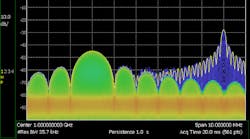Portable Testers Add Real-Time Spectrum Analysis to 50 GHz
This file type includes high resolution graphics and schematics when applicable.
On-site spectrum analysis once implied the use of a “portable” instrument with a battery almost large enough to start an automobile. But portable RF/microwave test instruments have come a long way, and lightweight units such as the FieldFox analyzers from Keysight Technologies provide a number of measurement functions from a battery-powered package weighing just 7.1 lb. (3.2 kg).
Just added as an option to 16 models in the FieldFox line is real-time spectrum-analysis (RTSA) capability. Available over a total frequency range of 9 kHz to 50 GHz, it captures the most elusive signals—including multiple pulses, interference, and other signals occupying a band of interest. With outstanding efficiency, these portable analyzers can run for nearly four hours on a single battery charge for thorough, on-site RTSA measurements.
The FieldFox analyzers (Fig. 1) are compact and light in weight, yet quite rugged and lacking none of the power and accuracy of much larger, laboratory benchtop analyzers. They show captured signals on a bright 6.5-in. diagonal thin-film-transistor (TFT) display and are available with a variety of measurement functions, including as combination instruments with cable and antenna tester (CAT), spectrum analyzer, and vector network analyzer (VNA).
The 16 models available with RTSA option 350 (see table) include spectrum analyzers and combination analyzers with built-in power meters, frequency counters (with 1-Hz resolution), and a Global Positioning System (GPS) receiver for precise location of detected signals. The internal GPS receiver, which has a female SMA connector for attachment of a GPS antenna, can also be used as a frequency reference.
Although battery powered, these analyzers perform very much like larger benchtop instruments, with frequency resolution of 1 Hz for signals to 5 GHz, 1.34 Hz for signals to 10 GHz, 2.68 Hz for signals to 20 GHz, 5.36 Hz for signals to 40 GHz, and 8.04 Hz for signals to 50 GHz. The dedicated reference oscillator is accurate to ±0.7 ppm plus the aging rate, which is ±1 ppm/year for 20 years.
When locked to a GPS signal, the frequency accuracy improves to ±0.010 ppm. The nominal zero-span sweep time can be set from 1 µs to 1000 s, with 100-ns resolution. The zero-span 3-dB RBW is settable from 10 Hz to 5 MHz in a 1-3-10 sequence. Video bandwidth range is 1 Hz to 5 MHz. The amplitude accuracy at center frequency ranges from ±0.8 to ±1.4 dB depending on frequency.
An RTSA Example
One of the widest-frequency analyzers, model N9952A, has a real-time bandwidth of 10 MHz that can be swept across a total frequency range of 9 kHz to 50 GHz. It features a wide dynamic range of 105 dB and spurious-free dynamic range (SFDR) of 63 dB. It can capture and display as many as four separate signal traces with a total of 561 points, using density spectrum, spectrogram, and real-time-spectrum displays. The N9952A FieldFox with RTSA capability can detect pulses as narrow as 22 ns even amidst surrounding signals and noise.
The analyzer achieves 100% probability of intercept (POI) with full amplitude accuracy for pulses as narrow as 12 µs. As with the other analyzers featuring the RTSA option, the N9952A provides flexible triggering, with free-run, external, video, and RF burst triggers using positive- or negative-edge trigger slopes. Trigger delay times can be set from 150 ms to 10 s with 100-ns resolution. The built-in power meter in the N9952A covers a frequency range of 300 kHz to 50 GHz.
For a given frequency range, these FieldFox portable analyzers with RTSA option can capture multiple simultaneous pulses or short-duration signal events within a channel of interest. The two pulses shown in Fig. 2 were acquired within a 20-ms acquisition time for a center frequency of 1 GHz, using a spectrum-analyzer resolution bandwidth (RBW) of 35.7 kHz and real-time bandwidth of 10 MHz. The pulse traces are formed from 561 points with display persistence set at 1 s.
When working with the firm’s new RTSA software, one of these FieldFox analyzers can capture and identify multiple simultaneous pulses within the capture bandwidth; work with a directional antenna to identify interference signals; and even verify wireless communications network operations, such as Long Term Evolution (LTE) uplink control and traffic signals (Fig. 3).
These portable analyzers with optional RTSA capability are compliant to MIL Class 2 requirements and are as home in commercial and industrial applications as they are in military test situations. They are well-suited for monitoring interference on two-way radio links, checking signals at satellite-communications (satcom) ground stations, capturing frequency-hopped signals, and verifying pulse sequences in military radar systems.
With their multiple display modes, such as spectrogram and real-time-spectrum displays, these FieldFox analyzers with optional RTSA capability can show small signals “hiding” within or in the presence of larger signals. They can serve as effective tools for checking on wireless communications signal carrier quality or for detecting the small signals emitted by improvised explosive devices (IEDs), even in the presence of much larger signals at airports.
The FieldFox microwave and spectrum analyzers with optional RTSA capability measure just 11.5 × 7.4 × 2.8 in. (292 × 188 × 72 mm). They are software-enabled and field-upgradable for keeping pace with changing measurement requirements. In addition to the many integral measurement functions already mentioned, these portable instruments also feature a built-in interference analyzer for the frequency range of the instrument, with included record and playback capability for analyzing captured interference.
Finally, the analyzers offer a number of different options, including for characterizing pulses found in radar and electronic-warfare (EW) systems, use of an external Universal Serial Bus (USB) power sensor, and remote control of the analyzer using smartphones or other wireless devices.
Keysight Technologies Inc., 1400 Fountaingrove Pkwy., Santa Rosa, CA 95403; (707) 577-2663
This file type includes high resolution graphics and schematics when applicable.






